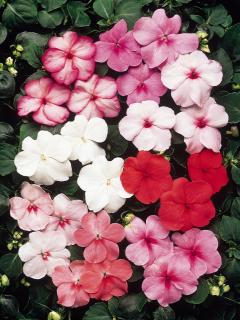Impatiens
Called Impatiens, garden balsam or busy lizzie, these popular garden plants have colourful single or double flowers. They are native to East Africa and grown in warm climate gardens around the world. In Western Australia most varieties are grown in the shade.
The leaves are hairless, the stems succulent and the ‘explosive’ fruits expel seeds when touched.
The fungus Plasmopara obducens affects impatiens species and cultivars. The disease causes stunting, premature leaf fall, poor flowering and death. The host range includes cultivated and wild species and has been found in single and double flowered varieties.
Symptoms
The first symptoms are usually pale green leaves. The underside of affected leaves may show a sparse or dense white layer covering the entire leaf surface. Affected leaves then yellow and may fall prematurely or collapse. Young plants and immature plant tissues are especially susceptible to infection. Symptoms are often first observed on terminal growth
Plants can be stunted, produce small pale leaves and few or no flowers. Early symptoms of infection may be difficult to detect as the characteristic white downy growth is restricted to the underside of leaves, and leaf symptoms may be confused with nutritional deficiencies or mite damage.
Spread
Downy mildew is spread by water splash and wind. The pathogen can survive in seed, soil, potting media or diseased plants for years before symptoms appear. Do not replant impatiens in the same area for several years. Downy mildew on Impatiens cannot spread to other plants outside the Impatiens group.
Most fungal infections on plants are encouraged by humid conditions. A high humidity environment can be the result of crowded plants with poor ventilation, or watering in the evening. Downy mildew is more prevalent when the weather is wet and humid. A film of water on the plant’s surface for more than six hours allows the downy mildew pathogen to germinate and infect. Dispose of infected plants in a sealed bag and place them in a bin. Do not add them to the compost heap.
Control
Preventive fungicides should be applied before the disease develops. Protectant fungicides such as mancozeb or a copper spray act as a barrier to the disease. Protect susceptible plants during cool wet weather when the disease is prevalent. These products are not absorbed by the plant and are washed off during watering or rain. Weekly applications may be required. New Guinea impatiens have a higher resistance to this disease.
Downy mildew checklist
- yellowish or pale green foliage
- downward leaf curl
- leaf distortion
- white to light grey growth on leaf undersides
- discoloured or pale emerging leaves
- flower buds may fail to form
- stunted plants.
Unfamiliar pests
The Department of Agriculture and Food, Western Australia (DAFWA) is on the lookout for animal and plant pests, diseases and weeds that could pose a threat to agriculture and the environment.
If you discover something unfamiliar, please send a photo to the Pest and Disease Information Service (PaDIS) by email: info@agric.wa.gov.au or phone them on Freecall: 1800 084 881.
Please read the sending specimens for identification web article before sending, or bringing in, samples to the Pest and Disease Information Service, 3 Baron-Hay Court, South Perth, 6151, WA.

